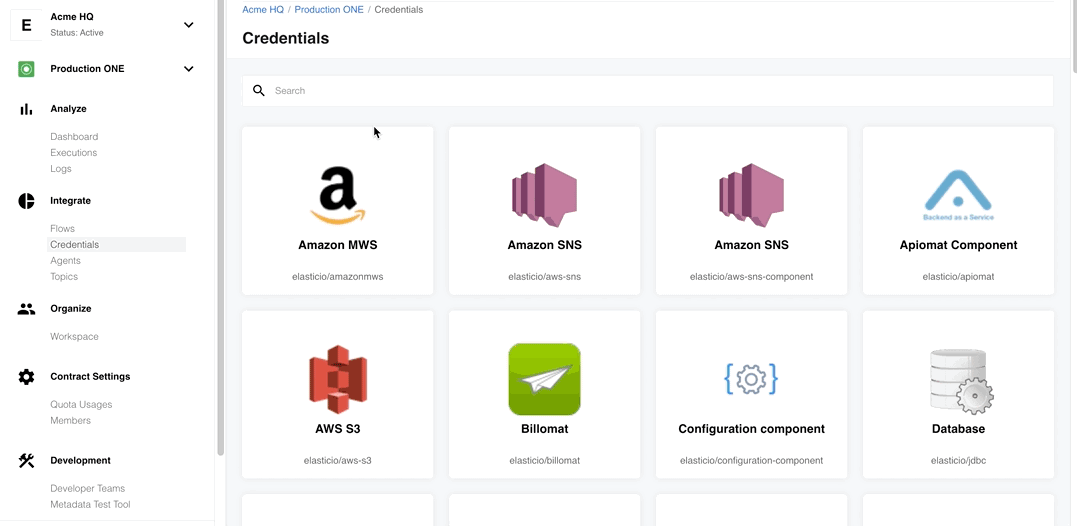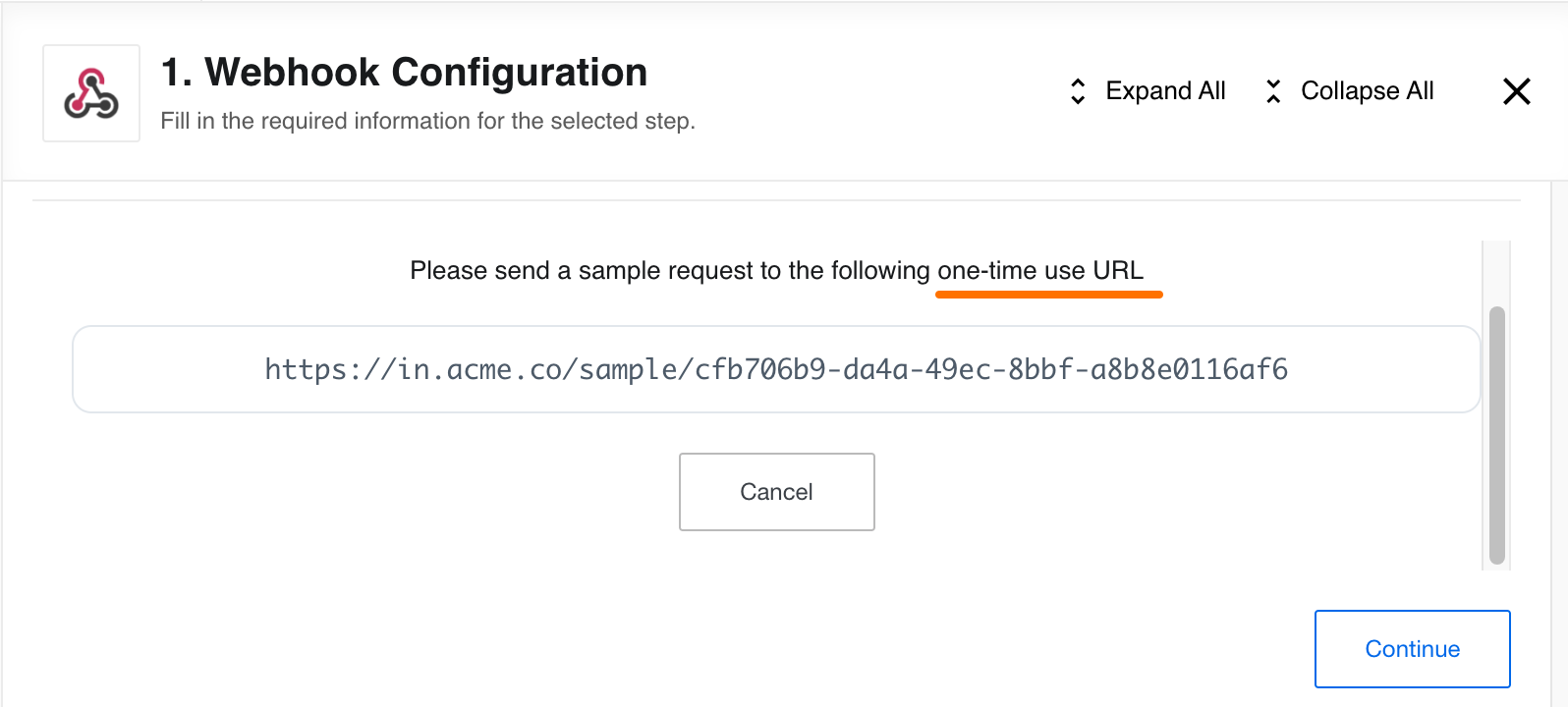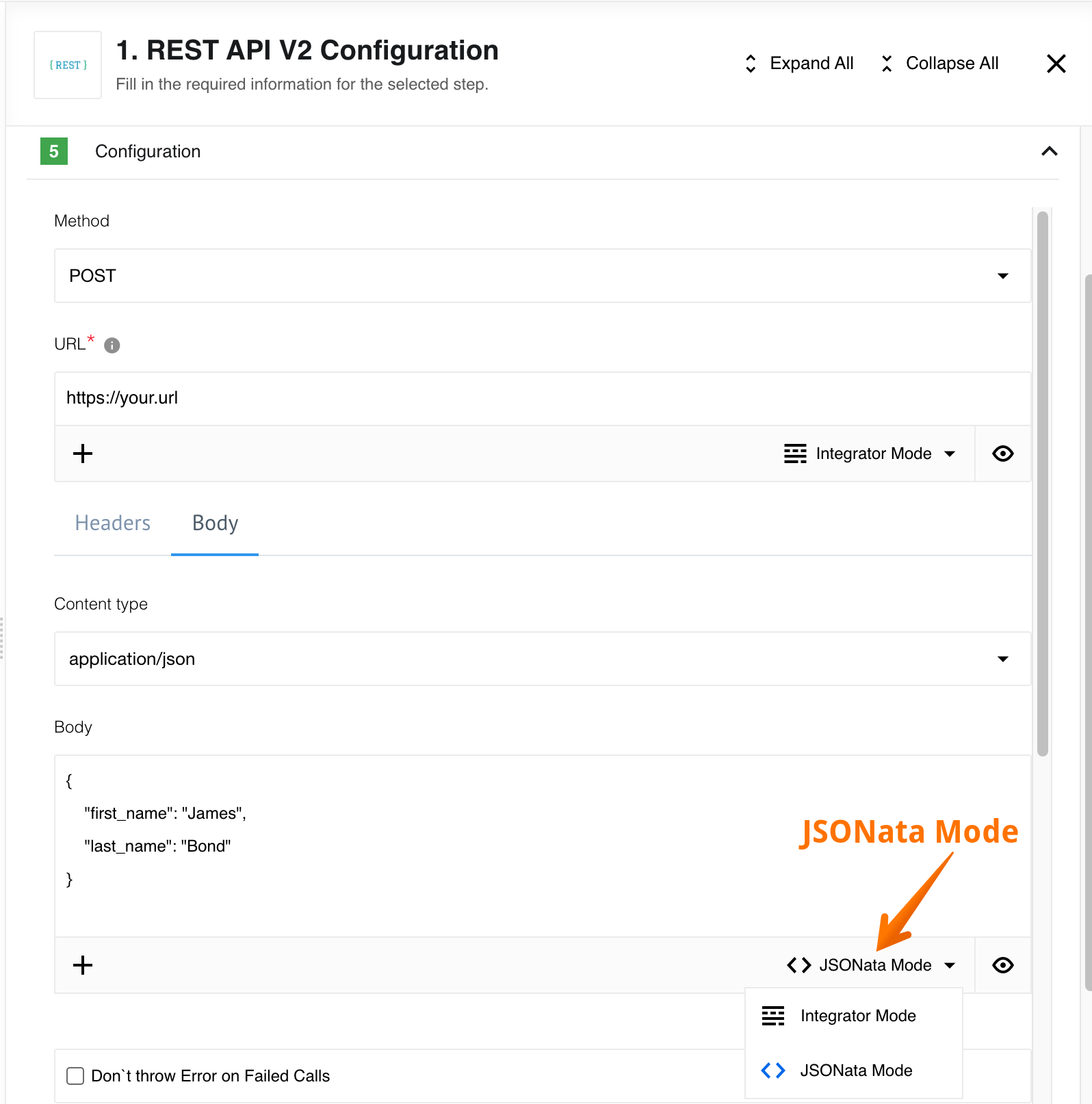Product Update - v22.38
Improvements
Credentials Page: Search by component name
In our quest to improve every aspect of our User Interface, we added a search function to the Credentials page. When you navigate to Integrate - Credentials you can now Search by component name to find the credential card you need instead of scrolling to find it.
WebHook Step: Send sample request
When you configure a webhook component step in your integration flow, you can either Send sample request or Add sample manually. When you select Send sample request a WebHook address is provided which you can use to send your example sample.
We also highlight that this address to be used only one-time to send a representative sample which you can use to configure subsequent steps in your integration flow.
REST-API-V2 component POST and PUT body type
To improve the user experience and prevent an accidental JSON data structure pasting
into the Body field while in an Integrator mode, we changed the User Interface
behaviour to default into JSONata mode when an application/json content type is
selected for the POST and PUT HTTP calls.
This change avoids possible errors when users forget to change the input field settings deom Integrator to JSONata mode.
Run-time environment variables
Components exchange information with various platform services using run-time environment variables during execution of each step of an integration flow.
We are constantly working to standardise and add new environment variables to streamline the information exchange. The following environment variables were added to the run-time:
-
WEBHOOK_URI- This environment variable will be available to each step in the flow which exchanges data with the webhook service, eg. WebHook or Flow-linking. This environment variable from the Tenant attributeswebhooks_domainor from the HELM3 environment variableWEBHOOKS_BASE_URIif the Tenant record is missing. -
ELASTICIO_CONTRACT_ID- To help with troubleshooting of errors in multi-contract cases this environment variable will be available during the run-time of every execution including:- Verify credentials
- Select model
- Dynamic metadata
- Generated samples and flow execution
Updates
Node.js Sailor version 2.7.0
A new version of Node.JS Sailor library 2.7.0 is released. This update is
preparatory groundwork for the message persistence feature.
Java Sailor version 3.4.0
A new version of Java Sailor library 3.4.0 is released. This update is
preparatory groundwork for the message persistence feature.
HELM3
We constantly improve different aspects of HELM3 deployments in collaboration with our partners. This section lists updates and improvements included in this release.
Iron-bank service Scalability
Iron-bank service collects statistics from the running integration flows. The
service is now running as Kubernetes DeamonSet together with
the cadvisor. This reduces the load on the system significantly and increases
the scalability of Iron Bank.
Externally Build Docker Components
Information in this section is intended for our customers who intend to extend the automatic component delivery to include custom developed components.
API changes
Added new endpoint to PATCH /v2/teams to add docker registry to a team. Check
the API documentation for the details.
Components Pusher changes
HELM3 configuration changes
To extend the automatic component delivery to include custom developed components, we
modified the componentsConfiguration section of HELM3 charts in the following way:
componentsConfiguration:
developmentTeam: teamName
components:
componentName:
# Image tag for pulling into the internal docker registry. Required, can be "latest"
targetTag: latest
# Image name by which to pull repo from registry. Optional, `team_name/repo_name` by default
dockerRepoName: "orgName/repoName"
# Team where create RepoBuild. Optional. Will override root `developmentTeam` on the `components` level
developmentTeam: teamName
# Access for the component in the platform context. Optional, `global` by default
access: team
Please Note: These are breaking changes and you should carefully revise your setup if you intend to use this feature.
developmentTeam- unchangedcomponentName- unchangedregistry,url,repoandtaggot changed intodockerRepoName,developmentTeam,targetTagandaccess. Please review these changes carefully.
Along with these changes the following new required variables were introduced:
DOCKER_REGISTRIES_ENCRYPTION_KEYused to encrypt credentials for docker registriesCOMPONENTS_PUSHER_AUTH_USERNAMEused to authenticate to components-pusher serverCOMPONENTS_PUSHER_AUTH_PASSWORDused to authenticate to components-pusher server
The components-pusher expects to find these variables to deploy the component docker images into your default team.
The new approach expects to also find a new optional TEAM_DOCKER_REGISTRY environment
variable in case of custom developed components. It is defined in the following way:
TEAM_DOCKER_REGISTRY:
uri: "https://index.docker.io/v1/"
credentials:
username: ""
password: ""
For the uri system expects string containg the address of docker registry.
The credentials object can have the following properties:
authFile- path of the authentication fileregistryToken- bearer token for accessing the source registryusernameandpassword
If none of the above are used - components-pusher will try to access the registry
anonymously.
Behavior Changes
The components-pusher is not longer a cronjob but a fully integrated service of
the platform. It runs in Kubernetes cluster in a single instance (replicas non-configurable).
The service runs following way:
- Regularly checks for new builds for repositories with
dockerTargetTagfields in therepodocuments. - When new builds of repository are detected they are copied into internal docker registry.
- The frequency of checks is configurable with the
.Values.componentsPusher.processLoopIntervalparameter of thecomponent-pusherservice. The frequency of checks is set in millisecond(ms). The default is 86400000 ms (1 day). - The
component-pusheruses the newly added internal endpoint (/copy/:component_id?version=:version) to pull of the specified component and version from docker registry. Uses basic authentication withCOMPONENTS_PUSHER_AUTH_USERNAMEandCOMPONENTS_PUSHER_AUTH_PASSWORDvalues defined in the HELM3 charts.
Gendry changes
createTeamtask now creates/updates default team with docker registry data from theTEAM_DOCKER_REGISTRYenvironment variable- New
createDefaultRepostask creates/updates components listed incomponentsConfiguration. Teams, in which these repositories are created, require to have docker registry data associated with them. If default team used - docker registry data will be taken fromTEAM_DOCKER_REGISTRYvariable. If any other team used - it needs to be patched with correct docker registry data using API endpointPATCH/v2/teams.
Fixed bugs
- Fixed the User Interface bug where the execution logs could not be copied.
- Fixed unexpected behavior of the Time Picker when filtering in the Threads and Execution pages.
- Addressed the limitation when credentials fields (
oauthand additional fields,baseUrl, etc ) could not be retrieved in theOAuthFieldView. Now all fields can be accessed directly from thecfgobject.
Components
Microsoft Dynamics CRM V2 component 1.0.0
Introducing new component for Microsoft Dynamics CRM.
- ADDED
Make Raw Requestaction
Marketo component 2.2.5
- FIXED the bug when non required field would show as required and block configuration of the step.
Shopware 6 component 1.1.0
- ADDED new authentication method using
CLIENT_IDandCLIENT_SECRETcredentials - ADDED
Lookup Object (at most one)action - ADDED
Lookup Objects (plural)action - ADDED
Upsert Objectaction - ADDED
Delete Object By IDaction - ADDED
Get New and Updated Objects Pollingtrigger
HJSON component 1.0.3
- UPDATED the
Sailorlibrary version to2.6.29 - UPDATED the
component-commonslibrary version to3.0.2 - FIXED the vulnerabilities in dependencies
Zendesk component 1.0.2
- UPDATED the
Sailorlibrary version to2.6.29 - UPDATED the
component-commonslibrary version to3.0.2 - FIXED the vulnerabilities in dependencies
VTEX component 1.4.3
- FIXED output metadata for the
Lookup Object (at Most 1)action for Object Type - Orders - FIXED incorrect behavior of the
Allow ID to be omittedoption in theLookup Object (at Most 1)action - UPDATED the
Sailorlibrary version to2.6.29
Shopify component 1.6.5
- ADDED retry on
429error (respecting theRetry-Afterheader)
Hubspot component 1.5.3
- FIXED the
Verifycredentials


